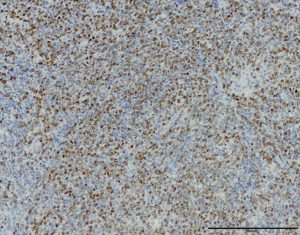

Scientists at UNC Lineberger Comprehensive Cancer Center are zeroing in on how Kaposi sarcoma-associated herpes virus can lead to cancer in people.
Infection with Kaposi sarcoma-associated herpes virus has been linked to the development of three human cancers, including Kaposi’s sarcoma, which is a cancer of the cells that line the blood vessels or lymphatic system, as well as two B lymphoproliferative diseases, primary effusion lymphoma and multicentric Castleman’s disease. Primary effusion lymphoma is a type of non-Hodgkin lymphoma with poor prognosis and survival rates.
UNC Lineberger researchers report in the Journal of Clinical Investigation how the viral protein vPK helps drive abnormal growth of immune cells called B cells. Their findings identify vPK as a potential druggable target to block or treat cancer in people infected with the virus.
“This viral protein, named KSHV vPK, or KSHV ORF36, when expressed in mice, can cause the mice to develop lymphomas at an eight-fold higher rate than mice that don’t express the viral gene,” said UNC Lineberger’s Blossom Damania, PhD, vice dean for research in the UNC School of Medicine, and the Boshamer Distinguished Professor in the UNC School of Medicine Department of Microbiology and Immunology, who led the study.
The study’s first author, Penny Anders, PhD, postdoctoral research associate at UNC Lineberger, created a mouse model that incorporated ORF36, a viral gene that codes for the protein vPK. The mice with the viral protein experienced a greater incidence of lymphoma. Approximately 66 percent of mice with the viral gene developed lymphoma, compared to 8 percent who did not have the gene. The mice with the viral gene had higher levels of inflammation, which is often associated with cancers of various types.
In addition, the authors detected tumors in the modified mice that were similar to those seen in primary effusion lymphoma.
“Knowing that KSHV vPK has the potential to be oncogenic, we can develop therapies that target this viral protein to help treat KSHV-associated cancers,” Damania said.
The study was featured in a commentary published in the Journal of Clinical Oncology. To read the commentary, click here.
In addition to Anders and Damania, other authors include Nathan D. Montgomery, Aadra P. Bhatt, and Dirk P. Dittmer.
The study was supported by the National Institutes of Health, the Leukemia and Lymphoma Society and the Burroughs Wellcome Fund.
